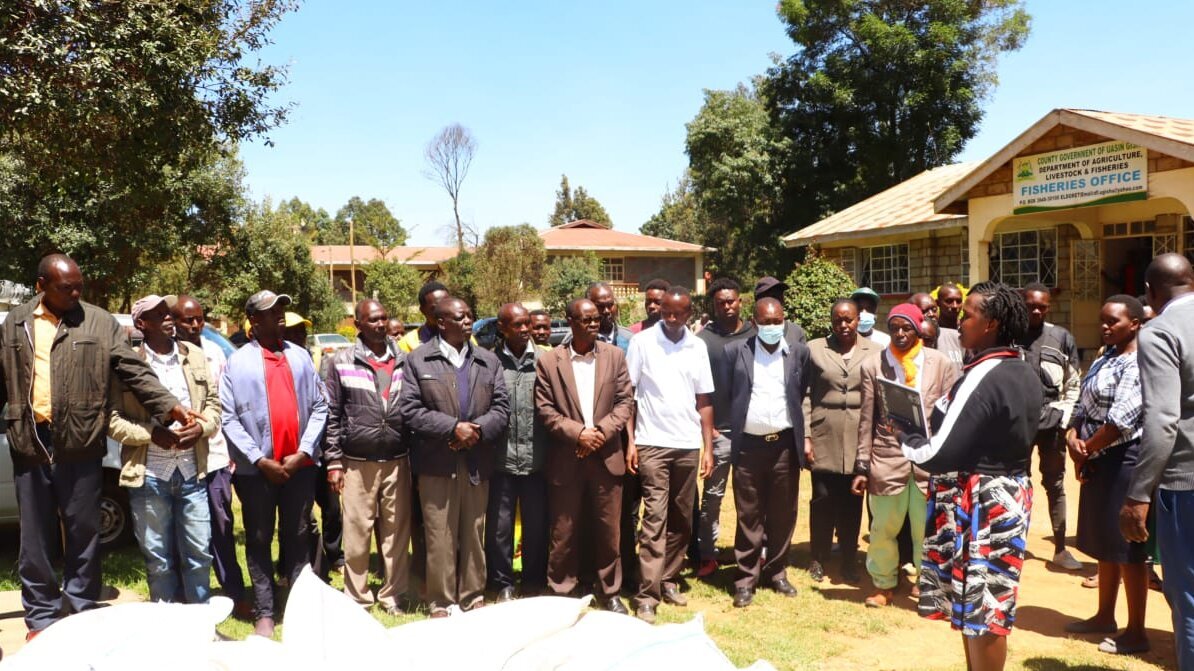Bii administration woos Uasin Gishu residents to embrace fish farming

Uasin Gishu County Government officials engage farmers during the distribution of fish feeds at the county's Fisheries Offices. The county has embarked on initiatives to woo locals to embrace fish farming to meet the growing demand in the region and tackle malnutrition. Photo/Jeremiah Choge
Uasin Gishu County Government has embarked on initiatives to woo local farmers to embrace fish farming to meet the growing demand in the region and tackle malnutrition.
According to the the county government, the current consumption stood at 82 tonnes annually and most fish was imported from neighboring countries like Uganda.
Livestock and Fisheries Chief Officer Nixon Cheplong said that the malnutrition levels stood at 41 percent despite being a traditional food basket and now the devolved unit is encouraging farmers to engage in fish farming beside traditional crops such as maize and wheat.
“We are targeting to ensure that each individual can consume 10 kilogrammes annually. With a population of 1.2 million, we want to increase production to meet this demand and we are also encouraging the local communities to consume the white meat since it is nutritious,” said Mr Cheplong.
Speaking during the distribution of fish feeds at the county's Fisheries Offices, the official elaborated on the importance of cooperation among farmers to fully realise the potential of fish farming in the region.
He disclosed that the devolved unit was providing subsidized 470,000 fingerlings in 2024 to shore up local fish production in the 600 fish ponds and dams across the county.
"I also call on fish farmers to embrace a cooperative structure to provide them with essential bargaining power that can significantly enhance the efficiency of their fish farming activities," he said.
“Currently, we are also stoking over 300 dams. We also have the demonstration farms in all sub-counties to enable farmers to learn new technologies," added the Chief Officer.
According to Governor Jonathan Bii's administration, the number of ponds in the region before the onset of devolution had dropped by nearly half due to high cost of feeds and lack of knowledge on how to manage them.
Mr Cheplong added that with the 400 fish ponds each producing 250kg of fish annually the total production is projected that it will be approximately 100,000kgs valued at Sh30 million.
With this strategies, the county government projects that the amount of fish ponds production will increase from 100,000kgs to over 330,000kgs annually valued at Sh150 million due to rising demand.
The devolved unit also conducts weekly eat-more fish campaigns, dubbed Fish Friday, where over 100 fishes are sold while the farmers are taught about modern technologies.
“We are also promoting other modern technologies such as aquaponics and biofloc technologies aimed at increasing production and productivity as well as cut down on the cost of feeding thus increasing profits in fish farming,” said Mr Cheplong.
He revealed that the devolved unit in partnership with the National Government is considering putting up an Aquaculture Centre of Excellence at Chebrorwa ATC in Moiben Constituency to boost fish production through production of quality feeds, research, and intensive fish production.
Director of Fisheries Edna Kemei also emphasized the importance of continued investment in training and resources to help farmers optimize their fish farming practices.
According to Kemei, the distribution of fish feeds marks a significant step in the County's commitment to fostering sustainable aquaculture development.
While an aquaculture project started under the Economic Stimulus Package (ESP) in 2009 collapsed, the current initiative seeks to revive it.
The country’s fish production then had grown from a meagre 2,000 metric tonnes to 70,000 metric tonnes through aquaculture but production went down.
Kenya is trying to plug the deficit by promoting aquaculture through the Economic Stimulus Programme that started with the regime of Third President of Kenya, the late Mwai Kibaki.
When the programme was established in 2008, fish production was at 1,000 tonnes a year, a figure that has grown to 22,000 tonnes.
Aquaculture provides up to 24 per cent of the country’s total fish production, with the balance coming from lakes and oceans.
Kenya is yet to attain the full potential in fishing at the Indian Ocean.
Under the Exclusive Economic Zones, local fishermen are allowed to fish up to 200 nautical miles from the Kenyan shores, but they are operating at below five(5) nautical miles for lack of appropriate fishing gear to explore the deep sea waters.

Be the First to Comment